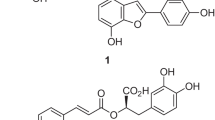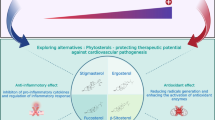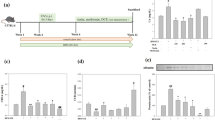Abstract
Hypercholesterolemia is a well-known etiological feature for cardiovascular diseases and a common indication of maximum categories of metabolic disorders. Para methoxy cinnamic acid is one of the cinnamic acid derivatives as a natural product obtained from the rice bran oil as an active constituent and has the antioxidant property. The present study was designed to evaluate the hypolipidemic activity of P-methoxy cinnamic acid against high fat diet induced hyperlipidemia in experimental rats. Male Wistar albino rats were divided into five groups (n = 6), and high fat diet was used to induce the hyperlipidemia for 28 days. P-methoxy cinnamic acid was used in two different doses (40 and 80 mg/kg body weight), and they were administered orally to the rats for 28 days during high fat diet. Atorvastatin (5 mg/kg) was used as reference standard. A significant elevated level of lipid abnormalities and tissue antioxidant parameters were reversed from normal level by the treatment of P-methoxy cinnamic acid in both the doses. Histopathological evidence further supported the protective action. Based on the initial findings, it was concluded that P-methoxy cinnamic acid was able to offer significant protection against high fat diet induced atherosclerosis. Future studies were recommended to identify the molecular mechanism of P-methoxy cinnamic acid against atherosclerosis protection.

Similar content being viewed by others
Data Availability
The data presented in this work are freely accessible to any other concerned researchers or students.
References
Fidèle, N., Joseph, B., Emmanuel, T., & Théophile, D. (2017). Hypolipidemic, antioxidant and anti-atherosclerogenic effect of aqueous extract leaves of Cassia occidentalis Linn (Caesalpiniaceae) in diet-induced hypercholesterolemic rats. BMC Complementary and Alternative Medicine, 17(1), 76.
Li, C., Zhang, W., Zhou, F., Chen, C., Zhou, L., Li, Y., Liu, L., Pei, F., Luo, H., Hu, Z., Cai, J., & Zeng, C. (2013). Cholesteryl ester transfer protein inhibitors in the treatment of dyslipidemia: A systematic review and meta-analysis. PLoS One, 8, e77049.
Capewell, S., Ford, E., Croft, J., Critchley, J., Greenlund, K., & Labarthe, D. (2010). Cardiovascular risk factor trends and potential for reducing coronary heart disease mortality in the United States of America. Bulletin of the World Health Organization, 88, 120–130.
Ntchapda, F., Maguirgue, K., Adjia, H., Etet, P. F., & Dimo, T. (2015). Hypolipidemic, antioxidant and anti-atherosclerogenic effects of aqueous extract of Zanthoxylum heitzii stem bark in diet-induced hypercholesterolemic rats. Asian Pacific Journal of Tropical Medicine, 8(5), 359–365.
Kuklina, E. V., Yoon, P. W., & Keenan, N. L. (2009). Trends in high levels of low-density lipoprotein cholesterol in the United States, 1999–2006. Journal of the American Medical Association, 302(19), 2104–2110.
Sharma, P. (2011). Cinnamic acid derivatives: A new chapter of various pharmacological activities. Journal of Chemical and Pharmaceutical Research, 3(4), 403–423.
Paim, R. T. T., Rodrigues, P. S. A., da Silva, J. Y. G., de Paula Junior, V. F., da Silva, B. B., De Freitas, C. A. S., Oriá, R. B., Florean, E. O. P. T., Rondina, D., & Guedes, M. I. F. (2020). p-Methoxycinnamic acid diesters lower dyslipidemia, liver oxidative stress and toxicity in high-fat diet fed mice and human peripheral blood lymphocytes. Nutrients, 12(1), 262.
Arruda Filho, A. C. V., Rodrigues, P. A. S., Benjamin, S. R., Paim, R. T. T., Holanda, M. O., Silva, J. Y. G., Milo, T. S., Vieira, I. G. P., Queiroz, M. G. R., & Guedes, M. I. F. (2017). Hypolipidemic activity of P-methoxycinnamic diester (PCO-C) isolated from Copernicia prunífera against Triton WR-1339 and hyperlipidemic diet in mice. Environmental Toxicology and Pharmacology, 56, 198–203.
Rodrigues, P. A. S., Guedes, I. F., Marques, M. M. M., da Silva, I. N. G., & Vieira, I. G. P. (2014). Hypoglycemic activity of copernicia cerifera mart. leaf powder extract in the treatment of alloxan-induced diabetic mice. International Journal of Pharmacy and Pharmaceutical Sciences, 6, 115–118.
Gunasekaran, S., Venkatachalam, K., Jeyavel, K., & Namasivayam, N. (2014). Protective effect of p-methoxycinnamic acid, an active phenolic acid against 1,2-dimethylhydrazine-induced colon carcinogenesis: Modulating biotransforming bacterial enzymes and xenobiotic metabolizing enzymes. Molecular and Cellular Biochemistry, 394(1–2), 187–198.
Okhawa, H., Qhishi, N., & Yagi, K. (1979). Assay for lipid peroxides in animal tissues by thiobarbituric acid reaction. Analytical Biochemistry, 95, 351–358.
Ellman, G. L. (1959). Tissue sulfhydryl groups. Archives of Biochemistry and Biophysics, 82, 70–77.
Kakkar, P., Das, B., & Viswanatham, P. N. (1984). A modified spectrophotometric assay of super oxide dismutase. Indian Journal of Biochemistry & Biophysics, 21, 130–132.
Aebi, H. (1984). Catalase in vitro. In: Packer L, Orlando FL (org.) Methods in enzymology. New York: Academic Press, pp. 121–126
Bradford, M. M. (1976). A rapid and sensitive method for the quantitation of microgram quantities of protein utilizing the principle of protein-dye binding. Analytical Biochemistry, 7, 248–254.
Pearson, T. A., Blair, S. N., & Daniels, S. R. (2002). AHA guidelines for primary prevention of cardiovascular disease and stroke: 2002 update: consensus panel guide to comprehensive risk reduction for adult patients without coronary or other atherosclerotic vascular diseases. Circulation, 106, 388–391.
Libby, P., Ridker, P. M., & Maseri, A. (2002). Inflammation and atherosclerosis. Circulation, 105, 1135–1143.
Van Gaal, L. F., Mertens, I. L., & De Block, C. E. (2006). Mechanisms linking obesity with cardiovascular disease. Nature, 444, 875–880.
Frota, K. G., Matias, A. C. G., & Arêas, J. A. G. (2010). Influence of food components on lipid metabolism: Scenarios and perspective on the control and prevention of dyslipidemias. Food Science Technology, 30(1), 7–14.
Ray, S. K., & Rege, N. N. (2000). Atorvastatin in the management of hyperlipidemia. Journal of Postgraduate Medicine, 46(3), 242–243.
Berrougui, H., Ettaib, A., Herrere Gonzalez, M. D., Luazez de Sotomayor, M. A., Bennani-Kabchi, N., & Hmamouchi, M. (2003). Hypolipidemic and hypocholesterolemic effect of argan oil in meriones shawi rats. Journal of Ethnopharmacology, 89, 15–18.
Takada, R., Saitoh, M., & Mori, T. (1994). Dietary gamma linoleic acid enriched oil reduces body fat content and induces liver enzymatic activity relating fatty acid beta oxidation in rats. The Journal of Nutrition, 124, 469–474.
Oh, J., Lee, S. R., Hwang, K. T., & Ji, G. E. (2014). The anti-obesity effects of the dietary combination of fermented red ginseng with levan in high fat diet mouse model. Phytotherapy Research, 28, 617–622.
Pande, V. V., & Dubey, S. (2009). Antihyperlipidemic activity of Sphaeranthus indicus on atherogenic diet induced hyperlipidemic rats. International Journal of Green Pharmacy, 4, 159–61.
Jorge, L. P., & Maria, E. G. (2009). The role of antioxidant and antioxidant related enzymes in protective response to environmentally induced oxidative stress. Mutation Research/Genetic Toxicology and Environmental Mutagenesis, 674, 137–147.
Ali, N. M., Yusof, H. M., Long, K., Yeap, S. K., Ho, W. Y., Beh, B. K., Koh, S. P., Abdullah, M. P., & Alitheen, N. B. (2019). Antioxidant and hepatoprotective effect of aqueous extract of germinated and fermented mung bean on ethanol-mediated liver damage. BioMed Research International, 2013, 693–613.
Author information
Authors and Affiliations
Contributions
The author contributed in this research work.
Corresponding author
Ethics declarations
Conflict of Interest
The author declares no competing interests.
Additional information
Publisher's Note
Springer Nature remains neutral with regard to jurisdictional claims in published maps and institutional affiliations.
Rights and permissions
About this article
Cite this article
Chen, C. Anti-atherosclerotic Activity of Para Methoxy Cinnamic Acid in High Fat Diet Induced Hyperlipidemia Model Rats. Appl Biochem Biotechnol 194, 1911–1924 (2022). https://doi.org/10.1007/s12010-021-03735-1
Received:
Accepted:
Published:
Issue Date:
DOI: https://doi.org/10.1007/s12010-021-03735-1




